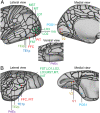Interspecies activation correlations reveal functional correspondences between marmoset and human brain areas
- PMID: 34493677
- PMCID: PMC8449355
- DOI: 10.1073/pnas.2110980118
Interspecies activation correlations reveal functional correspondences between marmoset and human brain areas
Abstract
The common marmoset has enormous promise as a nonhuman primate model of human brain functions. While resting-state functional MRI (fMRI) has provided evidence for a similar organization of marmoset and human cortices, the technique cannot be used to map the functional correspondences of brain regions between species. This limitation can be overcome by movie-driven fMRI (md-fMRI), which has become a popular tool for noninvasively mapping the neural patterns generated by rich and naturalistic stimulation. Here, we used md-fMRI in marmosets and humans to identify whole-brain functional correspondences between the two primate species. In particular, we describe functional correlates for the well-known human face, body, and scene patches in marmosets. We find that these networks have a similar organization in both species, suggesting a largely conserved organization of higher-order visual areas between New World marmoset monkeys and humans. However, while face patches in humans and marmosets were activated by marmoset faces, only human face patches responded to the faces of other animals. Together, the results demonstrate that higher-order visual processing might be a conserved feature between humans and New World marmoset monkeys but that small, potentially important functional differences exist.
Keywords: cortex; functional MRI; marmoset; naturalistic movie.
Conflict of interest statement
The authors declare no competing interest.
Figures





Similar articles
-
Functional mapping of face-selective regions in the extrastriate visual cortex of the marmoset.J Neurosci. 2015 Jan 21;35(3):1160-72. doi: 10.1523/JNEUROSCI.2659-14.2015. J Neurosci. 2015. PMID: 25609630 Free PMC article.
-
Cortico-Subcortical Functional Connectivity Profiles of Resting-State Networks in Marmosets and Humans.J Neurosci. 2020 Nov 25;40(48):9236-9249. doi: 10.1523/JNEUROSCI.1984-20.2020. Epub 2020 Oct 23. J Neurosci. 2020. PMID: 33097633 Free PMC article.
-
Functional MRI of visual responses in the awake, behaving marmoset.Neuroimage. 2015 Oct 15;120:1-11. doi: 10.1016/j.neuroimage.2015.06.090. Epub 2015 Jul 3. Neuroimage. 2015. PMID: 26149609 Free PMC article.
-
Anatomical and functional neuroimaging in awake, behaving marmosets.Dev Neurobiol. 2017 Mar;77(3):373-389. doi: 10.1002/dneu.22456. Epub 2016 Oct 21. Dev Neurobiol. 2017. PMID: 27706916 Free PMC article. Review.
-
Magnetic Resonance Imaging of Marmoset Monkeys.ILAR J. 2020 Dec 31;61(2-3):274-285. doi: 10.1093/ilar/ilaa029. ILAR J. 2020. PMID: 33631015 Free PMC article. Review.
Cited by
-
The Role of fMRI in Drug Development: An Update.Adv Neurobiol. 2023;30:299-333. doi: 10.1007/978-3-031-21054-9_13. Adv Neurobiol. 2023. PMID: 36928856
-
Action observation reveals a network with divergent temporal and parietal cortex engagement in dogs compared with humans.Imaging Neurosci (Camb). 2024 Dec 11;2:imag-2-00385. doi: 10.1162/imag_a_00385. eCollection 2024. Imaging Neurosci (Camb). 2024. PMID: 40800259 Free PMC article.
-
Neuroimaging of human and non-human animal emotion and affect in the context of social relationships.Front Behav Neurosci. 2022 Oct 21;16:994504. doi: 10.3389/fnbeh.2022.994504. eCollection 2022. Front Behav Neurosci. 2022. PMID: 36338883 Free PMC article. Review.
-
Revealing Complex Functional Topology Brain Network Correspondences Between Humans and Marmosets.bioRxiv [Preprint]. 2023 Nov 28:2023.08.17.553784. doi: 10.1101/2023.08.17.553784. bioRxiv. 2023. Update in: Neurosci Lett. 2024 Feb 6;822:137624. doi: 10.1016/j.neulet.2024.137624. PMID: 37645890 Free PMC article. Updated. Preprint.
-
Ultra-high field fMRI identifies an action-observation network in the common marmoset.Commun Biol. 2023 May 22;6(1):553. doi: 10.1038/s42003-023-04942-8. Commun Biol. 2023. PMID: 37217698 Free PMC article.
References
-
- Chen C.-Y., et al. ., Properties of visually guided saccadic behavior and bottom-up attention in marmoset, macaque, and human. J. Neurophysiol. 125, 437–457 (2021). - PubMed
Publication types
MeSH terms
Grants and funding
LinkOut - more resources
Full Text Sources
Medical

